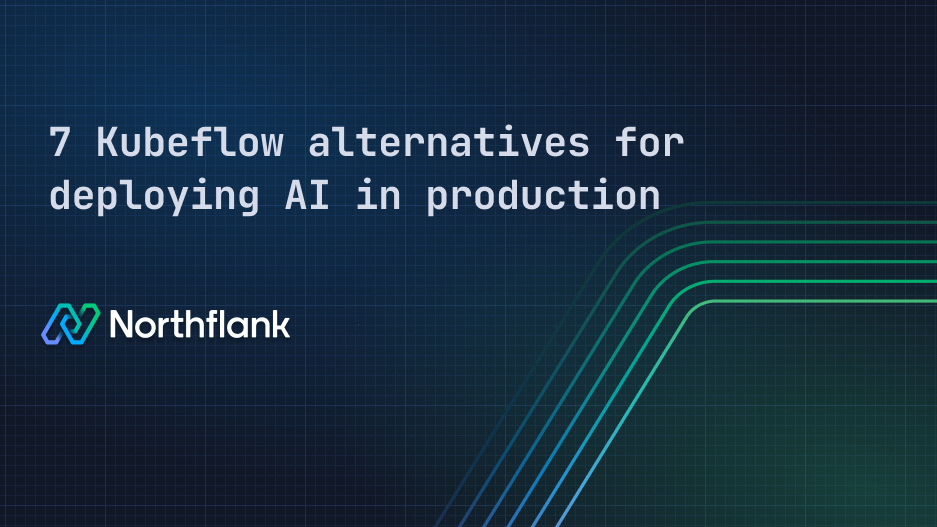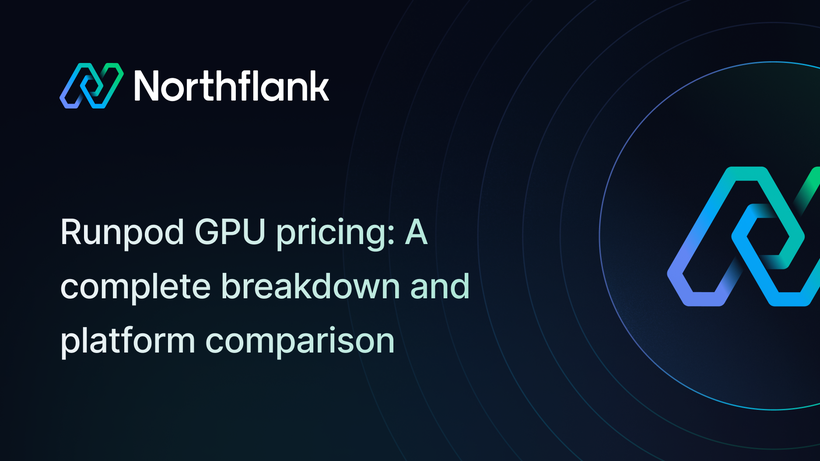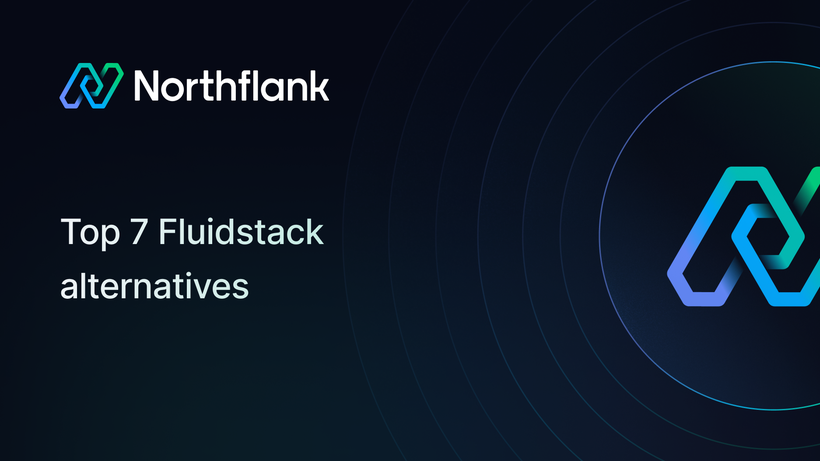

Top 7 Kubeflow alternatives for deploying AI in production (2025 Guide)
If you’ve spent any time deploying machine learning models in production, you’ve probably come across Kubeflow. It’s powerful, modular, and tightly integrated with Kubernetes, but it’s not for everyone. For teams without deep DevOps expertise, it can feel like overengineering just to get a model into production.
The good news? You have options. If you want simplicity, faster iteration, or just want to avoid managing Kubernetes altogether, there are solid alternatives. Platforms like Northflank abstract away the Kubernetes complexity, letting you deploy full-stack AI workloads with minimal DevOps effort.
In this guide, we’ll explore why teams are looking for Kubeflow alternatives, what to look for in a modern ML deployment stack, and which platforms are worth your attention.
If you're short on time, here’s a snapshot of the top Kubeflow alternatives. Each tool has its strengths, but they solve different problems, and some are better suited for real-world production than others.
| Platform | Focus Area | Strengths |
|---|---|---|
| Northflank | Full-stack AI apps: APIs, LLMs, GPUs, frontends, backends, databases, and secure infra | Production-grade platform for deploying AI apps, GPU orchestration, Git-based CI/CD, Bring your own cloud, secure runtime, multi-service support, preview environments, secret management, and enterprise-ready features. Great for teams with complex infrastructure needs. |
| MLflow | Experiment tracking & deployment | Lightweight, model versioning |
| Metaflow | Workflow orchestration | Pythonic, simple DAGs, AWS integration |
| Seldon Core | Model serving | Kubernetes-native, A/B testing, scalable |
| BentoML | Model serving/API creation | Fast model APIs, framework-agnostic |
| Vertex AI | Fully managed ML platform | End-to-end tooling, scalability, GCP native |
| Apache Airflow | Workflow orchestration & scheduling | DAGs, extensible, ecosystem-rich |
Kubeflow isn’t popular by accident. For all its complexity, it solves real problems for teams operating at scale. Here’s where it shines:
- Modular by design: You can pick and choose the components you need. Just want pipelines? Use Pipelines. No need to adopt the full stack.
- Kubernetes-native: Kubeflow is built to run with Kubernetes, not alongside it. That means tight integration and full control over scheduling, scaling, and orchestration.
- Designed for scale: Distributed training across GPUs, multi-node clusters, and large datasets is where Kubeflow really earns its keep.
- Reproducibility baked in: From inputs and configs to artifacts and logs, everything is tracked, making it easy to re-run experiments or audit results.
- Strong community support: It has a deep ecosystem and a large user base, which makes troubleshooting and extending the platform a lot more manageable.
Earlier, we looked at what makes Kubeflow stand out, but let's be honest, it's not all smooth sailing. While Kubeflow solves hard problems, it introduces plenty of its own. Here's where teams often struggle:
- Painful setup: Getting Kubeflow running isn’t a quick task. Between Helm charts, Istio, custom resources, and a maze of YAML, setup can take hours, days, or weeks, depending on your expertise.
- High barrier to entry: It assumes you’re already fluent in Kubernetes. If not, be prepared for a steep learning curve and lots of trial and error.
- Heavy resource usage: Kubeflow isn’t lightweight. Even a minimal install eats up significant CPU and memory, making it a tough fit for smaller teams or projects.
- Brittle integrations: Core components like Pipelines, KFServing, and Katib aren’t always seamless. Keeping them in sync across versions can be frustrating.
- Limited multi-tenancy support: Isolating users or projects cleanly? Not easy. Multi-cloud setups? You’re largely on your own.
- Weak CI/CD story: Kubeflow doesn’t natively support modern CI/CD workflows. Integrating versioning, GitOps, and automated deployments usually means building and maintaining your own glue code.
- Not-so-friendly developer experience: Debugging jobs, monitoring workloads, and managing deployments through Kubeflow often requires dropping down into raw Kubernetes, which is not exactly friendly for fast iteration.
If Kubeflow is slowing you down, the goal isn’t just to find something simpler; it’s to find something that actually fits how modern ML teams work. Here’s what you should prioritize in a replacement:
-
Frictionless developer experience
You shouldn't need to know Kubernetes internals to deploy a model. Look for platforms with clean CLIs, UIs, or APIs that let you go from prototype to production quickly with minimal config and no boilerplate YAML.
-
Support for the full ML lifecycle
A deployment tool should go beyond inference. You’ll want support for background jobs, scheduled tasks, data processing, monitoring, and logging all within a single workflow.
-
Scalable, GPU-friendly infrastructure
Autoscaling, GPU workloads, and efficient job scheduling should be first-class features. Northflank, for instance, makes it easy to run GPU-enabled services without touching infrastructure config.
-
Integrated CI/CD pipelines
Versioned deployments, automatic builds, and preview environments tied to your Git workflow can save hours. Northflank includes this out of the box, so teams can push code and deploy seamlessly.
-
Security and access control by default
Features like RBAC, audit logs, SSO, and secrets management should be easy to configure and ready for production use, not bolted on late.
-
Deployment flexibility
Whether you're in a single cloud, hybrid, on-prem, or air-gapped, your platform should adapt, not force you to rewrite your setup. Multi-region support, isolated environments, and policy-based controls all make a big difference.
Once you know what you're looking for in an alternative, it becomes easier to filter out tools that don’t align with your workflow. Here are six strong alternatives to Kubeflow, each solving different parts of the AI/ML deployment puzzle.
Northflank isn’t just a model hosting or GPU renting tool; it’s a production-grade platform for deploying and scaling full-stack AI products, and it's built on top of Kubernetes. But unlike Kubeflow, Northflank abstracts away the operational complexity of K8s, so you get all the power without needing to become an expert in YAML, Helm, or cluster management.
Whether you're serving a fine-tuned LLM, hosting a Jupyter notebook, or deploying a full product with both frontend and backend, Northflank offers broad flexibility without many of the lock-in concerns seen on other platforms.

Key features:
- Built on Kubernetes, but with a simplified, developer-first interface
- Bring your own Docker image and full runtime control
- GPU-enabled services with autoscaling and lifecycle management
- Multi-cloud and Bring Your Own Cloud (BYOC) support
- Git-based CI/CD, preview environments, and full-stack deployment
- Secure runtime for untrusted AI workloads
- SOC 2 readiness and enterprise security (RBAC, SAML, audit logs)
Pros:
- Kubernetes under the hood – full power and portability without the operational pain
- No platform lock-in – full container control with BYOC or managed infrastructure
- Transparent, predictable pricing – usage-based and easy to forecast at scale
- Great developer experience – Git-based deploys, CI/CD, preview environments
- Optimized for latency-sensitive workloads – fast startup, GPU autoscaling, low-latency networking
- Supports AI-specific workloads – Ray, LLMs, Jupyter, fine-tuning, inference APIs
- Built-in cost management – real-time usage tracking, budget caps, and optimization tools
Cons:
- No special infrastructure tuning for model performance.
Verdict:
If you're building production-ready AI products, not just prototypes, Northflank gives you the flexibility to run full-stack apps and get access to affordable GPUs all in one place. With built-in CI/CD, GPU orchestration, and secure multi-cloud support, it's the most direct platform for teams needing both speed and control without vendor lock-in.
See how Cedana uses Northflank to deploy GPU-heavy workloads with secure microVMs and Kubernetes
MLflow focuses on experiment tracking, model packaging, and reproducibility. It integrates well with major ML frameworks and allows you to register, version, and deploy models to various environments.

Key features:
- Experiment tracking, artifacts, parameters
- Model registry and versioning
- Works with many frameworks (scikit-learn, PyTorch, TensorFlow)
Pros:
- Simple and lightweight
- Open-source and easy to self-host
- Integrates into existing workflows
Cons:
- Limited serving capabilities
- No orchestration or full-stack support
- Doesn’t manage infrastructure
Verdict:
MLflow is great for teams that already have infrastructure in place and want a clean, open-source way to manage experiments and model versions.
Metaflow helps data scientists build and manage ML workflows with simple Python scripts. It handles DAGs, versioning, and integrates deeply with AWS for execution, storage, and scalability.

Key features:
- Python-native DAGs for ML pipelines
- Local-to-cloud portability
- Strong integration with AWS Step Functions
Pros:
- Very intuitive for Python developers
- Good for small teams or fast iterations
- Supports data versioning and retry logic
Cons:
- Limited support for GPUs or model serving
- AWS-focused; GCP and Azure users may need extra setup
Verdict:
Metaflow is ideal for ML engineers who want simple, Python-based orchestration without the overhead of full-scale platforms like Kubeflow.
Seldon Core is an open-source platform focused on serving ML models at scale. It supports advanced use cases like A/B testing, canary rollouts, and model explainability, but it assumes you're comfortable with Kubernetes.

Key features:
- Containerized model serving
- A/B testing, canary rollouts, model monitoring
- Native Kubernetes integration
Pros:
- High flexibility and customizability
- Great for organizations already using K8s
- Production-grade model serving
Cons:
- Requires Kubernetes expertise
- Steep learning curve
- Doesn’t handle model training or experimentation
Verdict:
If your team is comfortable with Kubernetes and needs industrial-grade model serving at scale, Seldon Core is a strong fit.
BentoML makes it easy to turn trained models into production-ready APIs. It supports multiple ML frameworks and outputs containerized services you can deploy anywhere.

Key features:
- Convert models into REST APIs
- Dockerized deployments
- Support for multiple ML frameworks
Pros:
- Very fast to go from model to API
- Lightweight and easy to use
- Great local development experience
Cons:
- No pipeline or orchestration features
- Requires extra tools for CI/CD, infra, scaling
Verdict:
BentoML is a great choice for quickly turning ML models into production-ready APIs, especially if you already have deployment infrastructure.
If you’re looking for alternatives to BentoML, see 6 best BentoML alternatives
Vertex AI is Google Cloud’s end-to-end ML platform. It provides everything from training to deployment, with tight integration into GCP services like BigQuery, AutoML, and Cloud Functions.

Key features:
- Integrated data prep, training, tuning, and deployment
- Built-in AutoML and LLM support
- Tight integration with GCP services (BigQuery, Dataflow, etc.)
Pros:
- End-to-end ML tooling in one place
- Strong scalability and performance
- Great for teams already using GCP
Cons:
- Locked into Google Cloud ecosystem
- Cost can grow quickly
- Less flexible for custom workflows
Verdict:
Vertex AI is perfect for enterprise teams heavily invested in GCP who want a fully managed, scalable ML platform with minimal setup.
Airflow is a popular workflow orchestrator built for managing complex DAGs. While not ML-specific, its flexibility and extensibility make it a core tool for automating data and ML pipelines at scale.

Key features:
- Python-based DAG definitions for full programmability
- Extensible with custom operators and plugins
- Scalable execution via Celery, Kubernetes, or other executors
- Deep ecosystem of integrations (e.g., GCP, AWS, Docker, Spark)
Pros:
- Battle-tested for workflow orchestration
- Flexible scheduling, retries, logging, and dependency management
- Large open-source community and enterprise support options
- Excellent observability and control over jobs
Cons:
- Not ML-native — no built-in model tracking, serving, or GPU management
- Requires infrastructure setup and maintenance
- Can become complex for teams unfamiliar with DAG-based workflows
Verdict:
Airflow is a strong choice for ML teams with complex pipeline orchestration needs, especially when working with data engineering teams or broader ETL processes. It's not an end-to-end ML platform, but it integrates well with others like MLflow, Vertex AI, or Seldon for a modular stack.
Once you understand where Kubeflow falls short and what modern tools offer instead, the next step is figuring out which tool actually fits your workflow. Here’s how to think through the decision:
| Consideration | Recommendation |
|---|---|
| Workflow scheduling & orchestration | Choose Northflank, Airflow or Metaflow |
| Team expertise | New to infra? Go with Northflank or Metaflow. |
| Infrastructure model | All-in on GCP? Use Vertex AI. Multi-cloud? Northflank is your friend. |
| Model lifecycle focus | Need full pipeline support? Try Northfank, Metaflow, or Airflow. |
| GPU support | Need GPU inference at scale? Northflank and Vertex AI shine. |
| Reproducibility & tracking | Northflank, MLflow, and Kubeflow Pipelines do this well. |
| Vendor lock-in tolerance | Prefer open tools? Northflank, MLflow, or Airflow will keep things portable. |
Kubeflow has earned its place in the MLOps community. But it’s not one-size-fits-all. If your team is struggling with the complexity or simply wants something faster and more intuitive, there are solid alternatives ready to meet you where you are.
If you're leaning toward a lightweight tool like MLflow, a cloud-native powerhouse like Vertex AI, or an all-around modern stack like Northflank, your best option comes down to your team’s strengths, workflow needs, and deployment goals.
The MLOps space is constantly growing, and it’s no longer about building the most powerful system; it’s about choosing the right one for the job.
If you're ready to see how Northflank fits into your workflow, you can sign up for free or book a short demo to explore what it can do.


